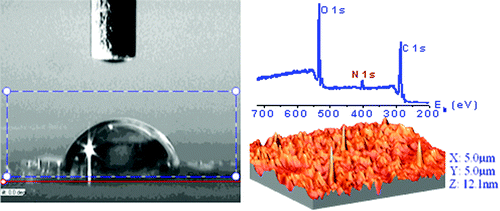C. López-Santos, F. Yubero, J. Cotrino, A.R. González-Elipe
ACS Applied Materials and Interfaces, 2 (2010) 980-990
doi: 10.1021/am100052w

Polyethylene terephthalate (PET) plates have been exposed to different nitrogen containing plasmas with the purpose of incorporating nitrogen functional groups on its surface. Results with a dielectric barrier discharge (DBD) at atmospheric pressure and a microwave discharge (MW) at reduced pressure and those using an atom source working under ultrahigh vacuum conditions have been compared for N2 and mixtures Ar + NH3 as plasma gases. The functional groups have been monitored by X-ray Photoemission Spectroscopy (XPS). Nondestructive oxygen and carbon depth profiles for the plasma treated and one month aged samples have been determined by means of the nondestructive Tougaard’s method of XPS background analysis. The surface topography of the treated samples has been examined by Atomic Force Microscopy (AFM), while the surface tension has been determined by measuring the static contact angles of water and iodomethane. It has been found that the DBD with a mixture of Ar+NH3 is the most efficient treatment for nitrogen and amine group functionalization as determined by derivatization by reaction with chlorobenzaldehyde. It is also realized that the nitrogen functional groups do not contribute significantly to the observed increase in surface tension of plasma treated PET.

